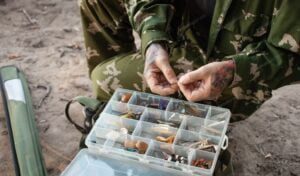
Hooks, however small they may seem, play a crucial role when comes to angling. They are available in different sizes and styles. Hence, picking the right one for your targeted catch can be a bit confusing, since most amateur anglers don’t know how fishing hook sizes work in the first place.
In this article, we will explain how fishing hook sizes work, and what are the available sizes, in an attempt to help you to pick the right-sized hook for your next fishing trip. So, read on.
Different Fishing Hook Sizes
There are quite a few methods that manufacturers use to size their hooks. Here are some of the most common fish hook sizes. We acquired most of this information from TetraHook, a reliable source for angling tips and techniques.
Numerical
This is one of the most common methods. It indicates hook size through numerical designations. The numbers typically range from 1 to 32. Here 1 represents the largest size, while 32 represents the smallest.
So, a hook labeled with a smaller number, such as 1 or 2, indicates a larger hook size. These hooks are suitable for catching larger fish species. On the other hand, larger values like 10 or 12 indicate smaller hook sizes. These hooks are ideal for smaller fish or finesse fishing.
Aught
Aught size is another common way to express fishing hook sizes. It uses a zero followed by a number to denote hook sizes. The larger the number, the smaller the hook. For example:
1/0 (one-aught) represents a larger hook suitable for bigger fish.
2/0 (two-aught) is slightly smaller than 1/0 but still considered large.
3/0 (three-aught) is smaller than 2/0 and appropriate for medium-sized fish.
Fractional
Another way that fishing hook sizes work is the fractional measurement, such as 1/16 or 1/32. These hooks are typically smaller and are often used for specific types of fishing, such as panfish.
Letters
Apart from numerical, aught, and fractional sizing, some hooks use letters and unique designations to specify their size. For example:
S (small) represents smaller hooks suitable for finesse fishing.
SS (stainless steel) represents stainless steel hooks.
X or XS (extra-small) represents very small hooks
How to Pick Up the Right Hook Size?
When you are choosing a hook size for your next fishing trip, there are several things that you need to consider, the most important of which is the species of fish you are targeting, as well as the type of bait or lure you will use to catch that. Hooked On Fishing offers tips and gear recommendations to make sure you’re fully prepared. Here are some general guidelines:
- Larger hooks (smaller numbers or higher aught values) are ideal for larger fish like bass, catfish, or pike.
- Medium-sized hooks (mid-range numerical values or aught sizes) work well for species like trout, walleye, or carp.
- Smaller hooks (higher numerical values or lower aught sizes) are suitable for panfish, crappie, or finesse fishing with light tackle.
End Notes
As an angler, it is really important to understand how hook sizes work. Whether you are casting for a giant bass or going after minnows, understanding and picking the right hook size will greatly enhance your chance of landing the catch you are targeting. It will also help you make a more informed choice whenever you are in the market for fishing gear.
Hopefully, this article was helpful and informative for you. Thanks for reading.
You might also like:

